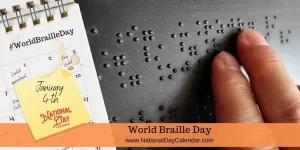 Every year on January 4th, World Braille Day reminds us of the importance of accessibility and independence for those who are blind or visually impaired.
Every year on January 4th, World Braille Day reminds us of the importance of accessibility and independence for those who are blind or visually impaired.
About 36 million people around the world are blind. By 2050, the number of people diagnosed with blindness is predicted to rise to 115 million. Those who are blind or who have severe vision impairments face many challenges in life. Some of these challenges include navigating new environments, using a computer, handling cash, and arranging clothes.
Blind people have ways to successfully deal with many of these situations. In today’s world, advanced technology and voice activation make a blind person’s life much more manageable. But one invention, in particular, has helped countless numbers of blind people. This invention is called braille and it was developed nearly 200 years ago. Braille gives blind people the ability to read and even write letters. The system consists of raised dots that form letters and words which are read by touch.
Louis Braille
Louis Braille invented the reading system of raised dots in 1824. Born on January 4, 1809, in France, Louis would lose his sight after an accident in his father’s harness shop at the age of three. He would later attend the National Institute for Blind Children in Paris. There, his interest in music would benefit him when at the age of 10 he would meet Charles Barbier, a captain in Napolean’s army. The captain taught the students about a communication code using dots called Night Writing. Combining his knowledge of music and the inspiration of code communication, Louis Braille invented a 6 dot fingertip reading system when he was only 15 years old.
Louis died in 1852, two years before France’s Royal Institute for the Blind Youth adopted a braille curriculum. By 1916, schools in the United States were teaching braille to their blind students.


 dont souffrent les aveugles et les mal-voyants, mais aussi de rappeler l’existence du braille, un alphabet tactile.
dont souffrent les aveugles et les mal-voyants, mais aussi de rappeler l’existence du braille, un alphabet tactile.
 master his disability while still a child.
master his disability while still a child.